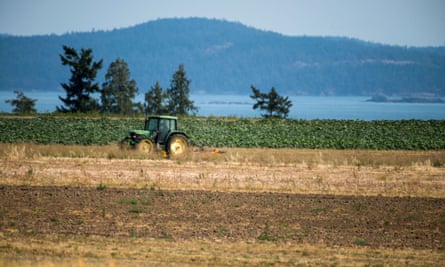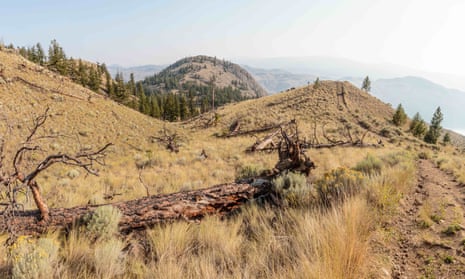Nearly a year ago, flood waters inundated swaths of south-western British Columbia. Mudslides destroyed sections of highways and swollen, turbid rivers washed away houses and bridges.
Now, the region has the opposite problem: months of drought have begun to take a toll on what was once dubbed Canada’s “wet coast”.
And as unpredictable weather events become a hallmark of a changing climate, experts warn that the two events are linked – and that a culture of overconsumption and poor resource management threaten to further amplify the effects of the current crisis.
The impact of the prolonged dry spell was underlined by recent footage showing some 65,000 dead salmon clogging a dried-up creek. More than 200 forest fires are blazing, and scores of heat records have fallen in recent weeks. The province’s energy regulator has already warned the drought will have an impact on its hydroelectric operations.
Eight communities have entered a level 5 drought, in which provincial authorities warn that “adverse impacts to socio-economic or ecosystem values” are nearly certain. On Monday, the Sunshine Coast, a community less than 100km (62 miles) north of Vancouver, declared a state of emergency as water supplies dwindled to dangerously low levels.
Other regions have seen similarly dismal conditions. In a typical four-month period between July and October, the British Columbia capital, Victoria, typically sees close to 100mm of rain. But since July, only 2mm have fallen on the parched ground. In the Fraser Valley, only 10mm have fallen – far below an average of 220mm.
But experts caution the severity of droughts are not just defined by a lack of precipitation. Instead, they say residents need to understand the extensive and complex systems of hydrology – and the impact that human actions have in magnifying the current crisis.

“The factors that cause a specific drought are randomly occurring over time. We simply cannot blame the current one on a lack of rain during the last several months,” said Younes Alila, an expert in forest hydrology and professor at the University of British Columbia. “To do so would be a big mistake.”
The largest source of water for replenishing the region’s creeks, streams and lakes is not rainfall but the accumulated snowpack in the mountains, Alila said.
The snow gradually accumulates through the season and as it eventually melts, it provides a consistent re-supply of water to groundwater aquifers and reservoirs.
Whenback-to-back atmospheric rivers – long, narrow bands of water vapour in the atmosphere that extend from the tropics to higher latitudes – passed over south-western British Columbia in November, they dropped an uncharacteristically large volume of rain at high elevations, wiping out portions of the snowpack.
“Ten months ago, when we lost 30 to 40cm of snow in 48 hours, that likely exacerbated the effects of droughts we’re seeing now,” he said. As a result, critical ground water recharge was far less than needed.
Experts have warned that the duration and severity of atmospheric rivers can be linked to climate crisis and are expected to increase in the coming years.

Alila also pointed to a number of other factors, often the result of human action, that have likely worsened the effects of the current drought.
Large scale-clear cutting of the province’s forests is among the worst culprits, dramatically altering the landscape of the province.
Newer forests, planted to replace what was cut down, consume far more groundwater than tracts of old growth. On the coast where the drought is worse, the problem is magnified: young coniferous trees consume water far more aggressively than their scarcity-adapted counterparts in the province’s interior. With less water available, the transpiration process is reduced, meaning trees release less moisture back into the air.
Even the creation of logging roads has a profound impact on groundwater recharge, diverting rainfall away from soil and into ditches that help drain the roads. Those ditches are connected to a network of culverts under the roads that are in turn lined up to existing gullies and channels.
The water is eventually pushed out to the ocean, instead of being absorbed by the ground. That recharge is particularly helpful in late summer and early fall months, when rainfall is the lowest.
“We’ve come to a point of no return in this province, because of the sheer amount of clear-cut logging they’ve been doing over the last 20 years. The damage is already done,” he said. “The least we can do is recognize the complexity of the processes and how land use can exacerbate the effects of changing climate.”
Experts also caution that a culture of overconsumption, aided by a belief by many residents that the country’s water resources are limitless, poses a danger for the future.
Zafar Adeel, a professor at Simon Fraser University’s school of sustainable energy engineering, says Canadians often have a “misguided” sense that fresh water is a limitless resource in the country.
“People tend not to really understand the consequences of continued excessive water usage,” he said, pointing to a number of lush green lawns in his neighborhood. “Particularly in [coastal] British Columbia, there’s a sense of immunity and this invincibility that we have enough – that we’ll never be out of water.”
Adeel also cautions that when the rains eventually come, the harder, clay-like consistency of the parched soil raises the risk of flash floods.
“There isn’t much we can really do in the short term when it comes to adaptation … And I don’t really know what the forecasts are for the next couple of months in terms of the amount of rainfall,” he said. “But if we get another atmospheric-river type event, God forbid we encounter that type of situation. I think it would be a lot more damaging than last year.”
